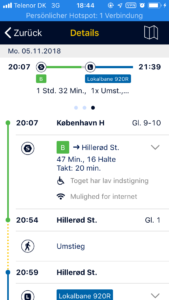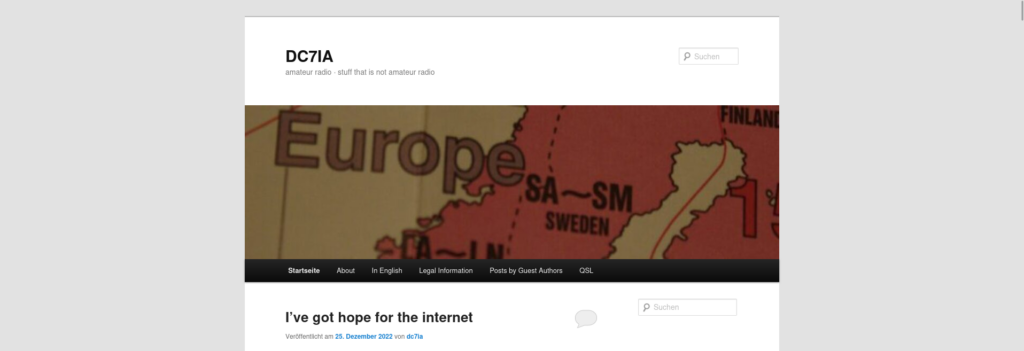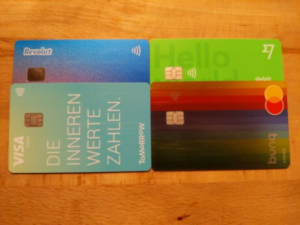Je mehr man im Ausland mit der Bahn unterwegs ist, desto mehr wundert man sich.
Ich war im April in Finnland unterwegs, dort bin ich mit einem Zug in der Ekstra Class unterwegs gewesen. Es gab kostenfreien Tee, Kaffee und Mineralwasser. Schließfächer für Wertsachen. Telefonie-Kabinen in denen man quatschen kann, ohne die Mitreisenden zu stören. Und wie in einem Flugzeug fuhr jemand mit einem kleinen Wagen rum und verkaufte Sandwiches. Für die Fahrt, die ich gebucht hatte, war das ein Preisunterschied von etwa fünf Euro. Anders als die 1. Klasse in Deutschland, ist diese Klasse zwar auch teurer, aber der Preisunterschied ist deutlich geringer. Die 1. Klasse ist zwar nett, aber nur für andere Sitze möchte ich nicht deutlich mehr zahlen. Lieber zahle ich 4,50 € für eine Sitzplatz-Reservierung in einem eigenen Abteil.

Bequeme Sitzgelegenheit mit WLAN, Steckdosen, Getränken, Zeitungen und Rezeption mit Abfahrtszeiten und freundlicher Auskunft.
Es gibt sogar Netzwerkdosen.
Letzten Dienstag war ich dann mit dem Thalys Schnellzug mit 300 km/h von Brüssel auf dem Weg nach Deutschland. Für 35 € war ich in der 1. Klasse Premium für unter 26 Jahre unterwegs. Aber halt, schon bevor es in den Zug ging fing der Komfort an: In der Thalys Lounge, direkt neben dem Bahnhof Bruxelles Midi.
Dort angekommen, habe ich mich direkt mit dem WLAN verbunden und das Thinkpad an die Steckdose gestöpselt. Etwas schwarzer Tee und die eine Stunde Umstiegszeit verging schnell. Es gab Schokolade, Obst, Kaffee und Tee. Eine kleine Auswahl an französisch-sprachigen Zeitschriften und LAN-Dosen. Die Zeit vergeht gleich viel angenehmer, wenn man nicht am Bahnhof rumsteht und wartet.

Schwarztee! Perfekt. Fehlt nur noch eine richtige Tasse anstatt eines Pappbechers.
Die Stühle sind bequem und es gibt auch Hocker. Ein Bildschirm zeigt die Abfahrtszeiten an, so hat man seine Abfahrt immer im Blick. Bei Fragen hilft einem das freundliche Personal am Empfang. Ich habe noch bisher keine der DB Lounges genutzt, obwohl ich manchmal passende Tickets hatte, nur war ich häufig abends unterwegs und die Lounge geschlossen. Also kann ich hier keinen Vergleich liefern.

Rechts: Mandarinenstückchen und grüner Tee (in den ich etwas zu viel Milch gekippt habe), zwischen der Tasse und dem roten Glas liegt eine kleine Tafel Schokolade.
Unter dem mit Mandel-Schoko-Creme gefüllten Milchbrötchen liegt ein Zahnstocher. Nicht auf dem Bild ist das Erfrischungstuch.
Sehr schön: Richtiges Besteck und echte Tassen. Hier wird darauf geachtet, dass nicht zu viel Müll anfällt.
Eine Weile später am Gleis angekommen, wurde ich direkt gefragt „Monsieur, puis-je vous aider?“ und in welchem Waggon ich denn sitzen würde. Anschließend wurde mir gesagt der Waggon 21 würde in dem Abschnitt am Ende des Bahnsteigs halten. So ging ich also hinüber und konnte entspannt einsteigen. Insbesondere, da darauf geachtet wurde, dass alle ausgestiegen waren, bevor man zum Einstieg aufgefodert wurde. Direkt nach Einstieg bekam jeder Fahrgast ein Erfrischungstuch. Schnell mit dem durchaus brauchbaren WLAN (1000 MB Datenvolumen) verbunden und die Zeit vertrieben. Nach einigen Minuten kam dann Essen: Ich hatte die Wahl zwischen Nudeln mit Huhn und einer Süßspeise, also habe ich die Süßspeise gewählt. Diese und der Tee waren natürlich im Ticketpreis bereits enthalten. Bei der Deutschen Bahn kann ich definitiv nicht 1. Klasse reisen für den Preis (35 €), von den ganzen Annehmlichkeiten wie Essen, Getränk oder auch nur brauchbarem WLAN mal ganz abgesehen. Zugegeben hatte das WLAN des Thalys auch nur bis zur Grenze zuverlässig funktioniert, kaum in Deutschland gab es dann wieder Aussetzer.
Ja, der Thalys ist definitiv nicht der Alltag. Die meisten Leute sind nicht jeden Morgen (und Abend) im Fernverkehr unterwegs. Auch ich nicht. Dennoch lässt sich an diesem Beispiel gut sehen, was in Deutschland noch möglich wäre. Aktuell könnte ich so etwas von der Deutschen Bahn leider nicht bekommen.
Einige andere Verbesserungen, die sich in Deutschland mehr auf den Alltag auswirken und für mehr Nutzung des Bahnverkehrs — anstelle von Individualverkehr — führen würden, habe ich in Dänemark erlebt. Ich habe bis Ende Juni ein Jahr in Dänemark gewohnt und war dort zwar nicht mit dem Fernverkehr unterwegs,

Rejseplanen – mit dieser App können Reisen in Dänemark geplant werden.
aber der Nahverkehr war dort schon deutlich besser ausgebaut als in Deutschland. Damit meine ich gar nicht mal unbedingt nur den Netzausbau, sondern eher die Infrastruktur der Rejsekort, ein kontaktloses System mit dem sich alle Züge, Busse, Metros, Straßenbahnen, Fähren, usw. in Dänemark nutzen lassen. Auf die Karte wird Guthaben aufgeladen und beim Einsteigen in den Zug hält man die Karte an einen Leser am Gleis um einzuchecken. Am Ziel checkt man dann aus. Steigt man um checkt man noch einmal ein, so weiß das System welche Strecke man genommen hat. Der Preis wird anhand der Entfernung berechnet. Außerhalb der Tageszeiten mit den höchsten Auslastungen ist das Ganze etwas günstiger. Alle Fahrten, egal ob mit Bus im Nahverkehr oder Zug im Fernverkehr, lassen sich für Dänemark mit der App Rejseplanen planen (und dann mit der Rejsekort nutzen). Rejseplanen bedeutet „der Reiseplan“, ein durchaus passender Name. Du gibst eine Adresse oder eine Bahnstation ein und die App sagt dir, wie du dorthin kommst. Wenn man der App dann noch Zugriff auf die Position gibt, sagt die einem sogar auch noch gleich was die nächste Station ist und man muss nicht einmal wissen, welches die nächste Station ist. Besonders eine Karte wie die Rejsekort fehlt mir hier in Deutschland. Ausreichend Guthaben vorrausgesetzt, kann ich einfach überall einsteigen, ich muss mir keine Sorgen um das richte oder beste Ticket machen. Auch keine Sorgen muss ich mir darum machen schlecht informiert zu sein, denn Rejseplanen zeigt zuverlässig eventuelle Verspätungen und Gleiswechsel an, was aber in Dänemark ohnehin nur selten vorkam. Was dafür häufiger als in Deutschland vorkommt, ist WLAN in den Zügen. In jeder S-Bahn gibt es WLAN und das ganze ist auch noch brauchbar, selbst bei volleren Zügen. Auf Seeland gibt es die Lokalbane, diese Lokalbahn verbindet kleinere Orte, bei denen es in Deutschland wohl keine brauchbare Anbindung gäbe. Diese Züge haben zwar im Gegensatz zur S-Bahn kein WLAN, dafür ist aber das Handynetz in Dänemark gut genug um unterbrechungsfrei auf längeren Zugfahrten Youtube in HD nutzen zu können, ohne dass es Aussetzer gibt. Wer deutsche Netze gewohnt ist, findet vielleicht das schon seltsam, aber nach einem kurzen Moment kommt dann noch häufig die Nachfrage „Aber ist das nicht viel zu teuer Youtube zu gucken?“, worauf ich immer verneinen muss. Ich hatte ein 100 GB Datenpaket und selbst mit viel Youtube schauen habe ich das nicht aufbrauchen können. Das Datenpaket hat mich etwa 14 € (sic!) gekostet. Nicht nur bei Zügen hat Deutschland Ausbaubedarf, sondern auch bei anderer Infrastruktur. Aber bleiben wir bei den Zügen.
In Deutschland wäre die ca. 1,5-stündige Fahrt nach Kopenhagen, die ich häufiger gemacht habe deutlich teurer gewesen, als diese in Dänemark war. Ich habe etwa 16 € gezahlt, hin und zurück. Mit dem Zug in Deutschland unterwegs sein muss definitiv günstiger werden. Auch in Finnland waren die Preise weniger hoch.
Apropos Preise, bei der Deutschen Bahn lassen sich viele Verbindungen aus mir unverständlichen Gründen nicht als digitales Ticket buchen (egal ob zum Ausdrucken oder in der App), sondern nur per Brief bestellen. Und dann kommt auch noch Porto darauf. Warum? Hier wäre es schön nicht erst auf den Brief warten zu müssen und das Porto zu sparen.
Diese Beispiele aus drei Ländern zeigen schon ganz gut, dass hier noch einiges an Verbesserung möglich ist, bevor mehr Leute auf die Bahn wechseln.










